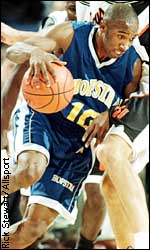
 | |
Last impressions are lasting
By Andy Katz
ESPN.com
The consensus is in from NBA scouts: The last impression makes the most difference.
|  | | Speedy Claxton helped himself more in pre-draft workouts than during his stellar senior season. |
Surprised? Players and fans have been over the past few weeks. The e-mails have flooded into ESPN.com with fans questioning how certain players can be left out of the first round in mock drafts.
The arguments usually are backed up by statistics from the previous season or head-to-head matchups. But, get this: It doesn't matter.
NBA scouts, general managers, player personnel directors and coaches said they look at the body of work. They do. But nothing beats a last impression when the player is in a team's gym doing the drills they want him to do.
That's why a late poor workout can crush a player's chances from being taken in the first round or the lottery.
"The last impressions are the most important," said Jim Kelly, Toronto's director of scouting. "That's why certain players move up at the Chicago pre-draft camp."
One of the best examples from this spring might be Indian Hills (Iowa) Community College center Ernest Brown. Scouts weren't enamored with his performances during the season. The consensus from NBA scouts, and even college coaches, was that he was far from a proven product. He was potentially an undrafted player. But the thinking on Brown changed in Chicago. He played well -- well enough to be considered a shot-blocker, rebounder and a developing offensive talent.
At 7-foot, Brown has the size, foot speed and long reach to be a factor on the floor. But scouts needed to see him against other big men in a more competitive situation.
"It's very important to get a read on a player from November to June," Sonics scout Steve Rosenberry said. "Look at Ernest Brown. When I first saw him, I didn't think he was draftable. But now look at him. He will be."
Brown has a slim chance to crack the first round. But he's a certain second-round pick. He wasn't in June. Yet, teams spend thousands of dollars traversing across the country checking out players in games and practices. All of the data goes into scouting files on every player. A growth chart starts but the end result is the player won't be taken if he's a failure in the spring.
Hofstra's Speedy Claxton led the Flying Dutchmen to the NCAA Tournament. But his performances in draft camps in Phoenix and Chicago earned him a first-round pick, not his scoring or leadership during the regular season. Look at Michigan's Jamal Crawford. Sure, he was the leading scorer for the Wolverines in just 17 games as a freshmen. But his two days in Chicago catapulted him into the first round. Why? The hierarchy of NBA teams saw him stand out against good competition three weeks before the draft.
Teams that have traditionally done well in the playoffs rely heavily on scouting for background. But much of the final decision will come from the power brokers (some GMs, team presidents and even coaches) who get a chance to see the players in June when their team has been eliminated.
"No coach, if he's a good NBA coach, is doing his job if he's watching college games during the season," said Dick Versace, Vancouver's new president. "You don't have time. You're trying to get your team to play into June."
But that's where the workouts become a must-see for the head coaches and decision makers. Houston has been a traditional late-June team. Rockets coach Rudy Tomjanovich has relied heavily on his scouting department. But as soon as the Rockets have been eliminated, he's one of the most important decision makers. That's why he was front and center at Chicago two weeks ago, checking to see who would catch his eye in the workouts for a potential second-round pick. He has been an integral part of the workouts for the Rockets' No. 9 pick.
"The whole year goes into a body of work, but Rudy has the final stamp on decisions," Houston scout Dennis Lindsey said. "He's always had a late start, but that's why the individual work is important. We then have plenty of tape work to back it up. That's how we show good tendencies."
But there is no replacement for a team seeing a player in action. That's why teams usually won't draft a player they haven't had in for a workout. It doesn't make sense. They can't get a gauge on how good a player is, his work ethic or his ability to adapt to tough situations when he's put in a pressure-cooker of a workout.
"So much is based on the last guy seen," said Larry Harris, Milwaukee's director of scouting. "There are other guys who get forgotten. Remember, out of sight out of mind. It happens."
Mostly for second-round picks. But it does occur. Players who didn't show up or weren't willing to work out will get pushed down. Skipping Chicago and turning down the chance to work out is a quick way to hurt a draft position. Agents should pick up on this and remember the last workouts matter most.
Andy Katz is a senior writer at ESPN.com.
| |
|

